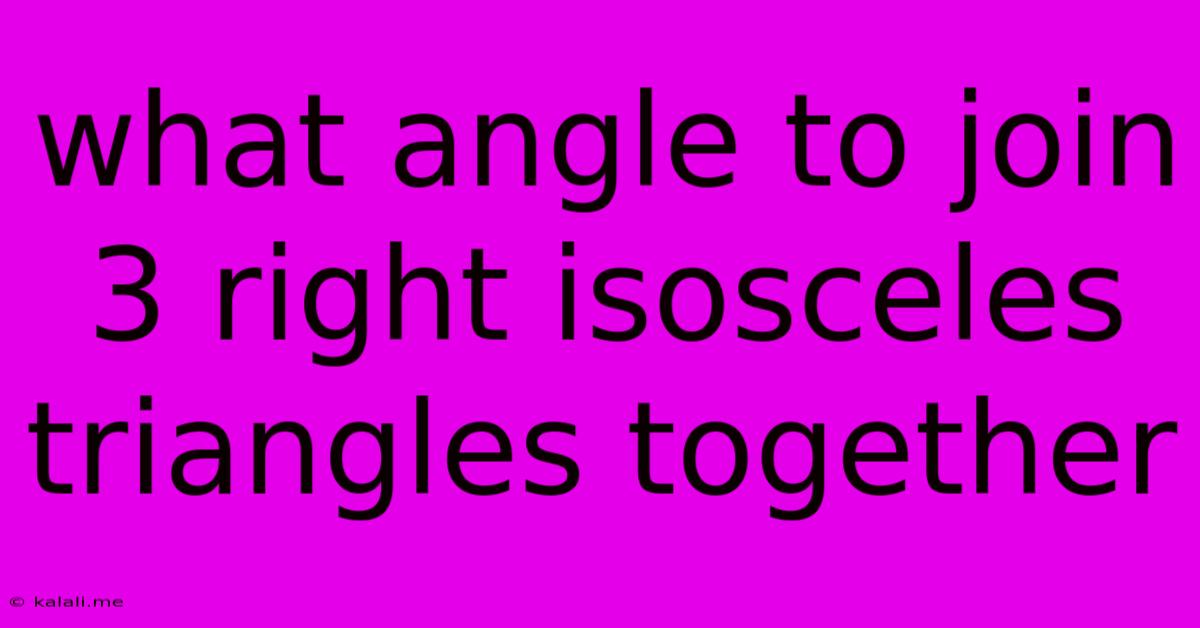What Angle To Join 3 Right Isosceles Triangles Together
Kalali
Jun 10, 2025 · 3 min read

Table of Contents
What Angle to Join 3 Right Isosceles Triangles Together? A Geometric Exploration
This article explores the different ways you can join three right isosceles triangles, focusing on the angles involved and the resulting shapes. Understanding the angles is crucial for various applications, from crafting geometric art to solving complex spatial problems. We'll delve into the possibilities and discuss the key geometric principles at play.
Right isosceles triangles, characterized by two equal legs and a right angle (90°), offer unique opportunities for construction. Their inherent symmetry allows for interesting arrangements when joined together. The challenge lies in determining the angles at which you need to connect them to create specific shapes or configurations.
Understanding the Angles
The key to joining these triangles lies in recognizing that each triangle has angles of 45°, 45°, and 90°. When joining them, you manipulate these angles to create new angles and shapes.
Method 1: Forming a Larger Triangle
The simplest method is to join the triangles along their hypotenuses. This results in a larger, similar right isosceles triangle. The angles of connection will be 90° at each joint, resulting in a larger triangle with angles of 45°, 45°, and 90°. This is a straightforward arrangement, but not the only possibility.
Method 2: Creating a Square
To create a square, you need to join two triangles along their hypotenuses and then attach the third triangle to one of the sides of the newly formed square. This involves joining angles of 90° and 45° to form right angles and ensure the correct square shape. Understanding the relationship between the hypotenuse and the legs of the right isosceles triangle (using the Pythagorean theorem) is vital here.
Method 3: Constructing Irregular Polygons
By cleverly manipulating the angles, you can create various irregular polygons. For example, joining two triangles along their hypotenuses and then attaching a third triangle to one leg of each of the previously joined triangles will result in an irregular pentagon. The precise angles at the vertices of this pentagon will depend on how you arrange the triangles. Experimenting with different angles will reveal a wide variety of possible shapes and polygons.
Method 4: 3D Structures
Joining three right isosceles triangles can also form the basis for 3D structures. By appropriately connecting the triangles, you can create building blocks for more complex three-dimensional shapes. The angles between connected triangles will determine the shape and angles of the 3D structure.
Practical Applications
Understanding how to join three right isosceles triangles has applications in various fields:
- Geometric Art and Design: Creating intricate patterns and designs in art, crafts, and architecture.
- Construction and Engineering: Building frameworks and stable structures.
- Game Development: Designing game levels and environments.
- Mathematical Modeling: Simulating and understanding complex geometric relationships.
Conclusion
The possibilities for joining three right isosceles triangles are numerous. The key is to carefully consider the angles involved, 45°, 45°, and 90°, and how they interact when the triangles are connected. Whether creating a larger triangle, a square, an irregular polygon, or even a 3D structure, a deep understanding of geometry is crucial. Through experimentation and careful planning, you can unlock a world of creative geometric designs. Remember to consider the context of your project to determine the most appropriate method for joining your triangles.
Latest Posts
Latest Posts
-
Most Southern Point In South America
Jun 11, 2025
-
What Is The Load Factor In Electrical
Jun 11, 2025
-
In The Periodic Table The Horizontal Rows Are Called
Jun 11, 2025
-
What Are The Vertical Rows On The Periodic Table Called
Jun 11, 2025
-
What Is The Difference Between A Pyramid And Prism
Jun 11, 2025
Related Post
Thank you for visiting our website which covers about What Angle To Join 3 Right Isosceles Triangles Together . We hope the information provided has been useful to you. Feel free to contact us if you have any questions or need further assistance. See you next time and don't miss to bookmark.